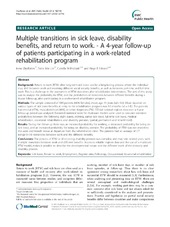| dc.description.abstract | Background: Return to work (RTW) after long-term sick leave can be a long-lasting process where the individual may shift between work and receiving different social security benefits, as well as between part-time and full-time work. This is a challenge in the assessment of RTW outcomes after rehabilitation interventions. The aim of this study was to analyse the probability for RTW, and the probabilities of transitions between different benefits during a 4-year follow-up, after participating in a work-related rehabilitation program. Methods: The sample consisted of 584 patients (66% females), mean age 44 years (sd = 9.3). Mean duration on various types of sick leave benefits at entry to the rehabilitation program was 9.3 months (sd = 3.4)]. The patients had mental (47%), musculoskeletal (46%), or other diagnoses (7%). Official national register data over a 4-year follow-up period was analysed. Extended statistical tools for multistate models were used to calculate transition probabilities between the following eight states; working, partial sick leave, full-time sick leave, medical rehabilitation, vocational rehabilitation, and disability pension; (partial, permanent and time-limited). Results: During the follow-up there was an increased probability for working, a decreased probability for being on sick leave, and an increased probability for being on disability pension. The probability of RTW was not related to the work and benefit status at departure from the rehabilitation clinic. The patients had an average of 3.7 (range 0–18) transitions between work and the different benefits. Conclusions: The process of RTW or of receiving disability pension was complex, and may take several years, with multiple transitions between work and different benefits. Access to reliable register data and the use of a multistate RTW model, makes it possible to describe the developmental nature and the different levels of the recovery and disability process. | en_US |

